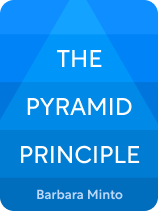

This article is an excerpt from the Shortform book guide to "The Pyramid Principle" by Barbara Minto. Shortform has the world's best summaries and analyses of books you should be reading.
Like this article? Sign up for a free trial here.
What should a conclusion include? Why should conclusions motivate readers?
In The Pyramid Principle, Barbara Minto claims you should end your writing piece in a way that motivates people. To do this, you need to present a new idea for readers to ponder over.
Continue reading to learn how a conclusion can make or break your piece.
Crafting a Motivating Conclusion
How do you end a conclusions-first piece of writing, and what should a conclusion include? Minto argues that you should end your piece with a new, motivating idea instead of simply restating your initial idea. A piece of Pyramid Writing doesn’t need a traditional concluding paragraph (in which you restate your main argument), since you’ve already shared your conclusions according to the conclusions-first approach. Instead, the best ending is one that presents a new idea: one that motivates your readers to either take your ideas seriously or take some sort of action. Let’s explore these two types of motivating endings.
Type 1: A Reminder of Your Ideas’ Significance
Minto claims that this type of ending provides context for why your ideas are important, which motivates readers to take your ideas seriously. For instance, imagine you’ve written a training manual for your employees. End your manual with these words: “Your day-to-day work—from contacting customers to filing receipts—keeps the business running and improves our customers’ lives.”
Type 2: A Call to Action
According to Minto, this type of ending motivates the reader to put your ideas into action. End with a call to action by sharing a specific action you’d like them to take and describing why it’s important. For example, imagine you’ve written an opinion piece to convince your readers to help formerly incarcerated people become voters. Your ending might be: “If you’re fed up with talking about change and are ready to spend time making change, join us at our meeting next week to learn how you can help ensure that eligible voters get to the polls by Election Day.”
When to Use Each Type of Ending
Minto doesn’t provide guidance on how to determine when to use each type of ending (or whether a neat ending is even necessary for your piece). To decide what your conclusion should include and which type of ending best suits your writing, consider the piece’s purpose. Experts often claim that a piece of nonfiction writing usually has one of these three purposes: to inform, express, or persuade. Here, we’ll explore which of Minto’s ending strategies (if any) may work best for each purpose.
Informative writing: The purpose of informative writing is to educate the reader on a specific topic. Examples include news articles, reports, training manuals, meeting agendas, and meeting minutes. End informative writing with a reminder of your ideas’ significance so that people feel their time reading your piece was well spent. If your informative writing requires a response from your reader, end with a call to action that specifies what you need from them.
Expressive writing: The purpose of expressive writing is to reveal your opinion or share your experiences. Examples include personal essays, opinion articles, thank-you messages, and memoirs. Expressive writing may not need a concluding paragraph if it’s already chronological in nature (as in the case of a memoir). However, as with informative writing, it may be useful to end your expressive writing with a reminder of your ideas’ significance.
Persuasive writing: The purpose of persuasive writing is to convince someone to agree with your perspective. Examples include editorials, advertisements, political speeches, and cover letters. It’s effective to end persuasive writing with a call to action: This type of ending will indicate that your perspective is useful because it leads to action. Furthermore, a call to action brings about the change you want to see, bringing you the satisfaction that your writing has a purpose.

———End of Preview———
Like what you just read? Read the rest of the world's best book summary and analysis of Barbara Minto's "The Pyramid Principle" at Shortform.
Here's what you'll find in our full The Pyramid Principle summary:
- How to write so clearly that you can get a point across within 30 seconds
- How to write a clear, compelling introduction, body, and conclusion
- Why you should always start your prose with your conclusion and work backward






